This post may contain affiliate links. Please read our disclosure policy.
How to zest a lemon with and without a zester using one of these five methods, including a microplane, box grater, or even just a knife!
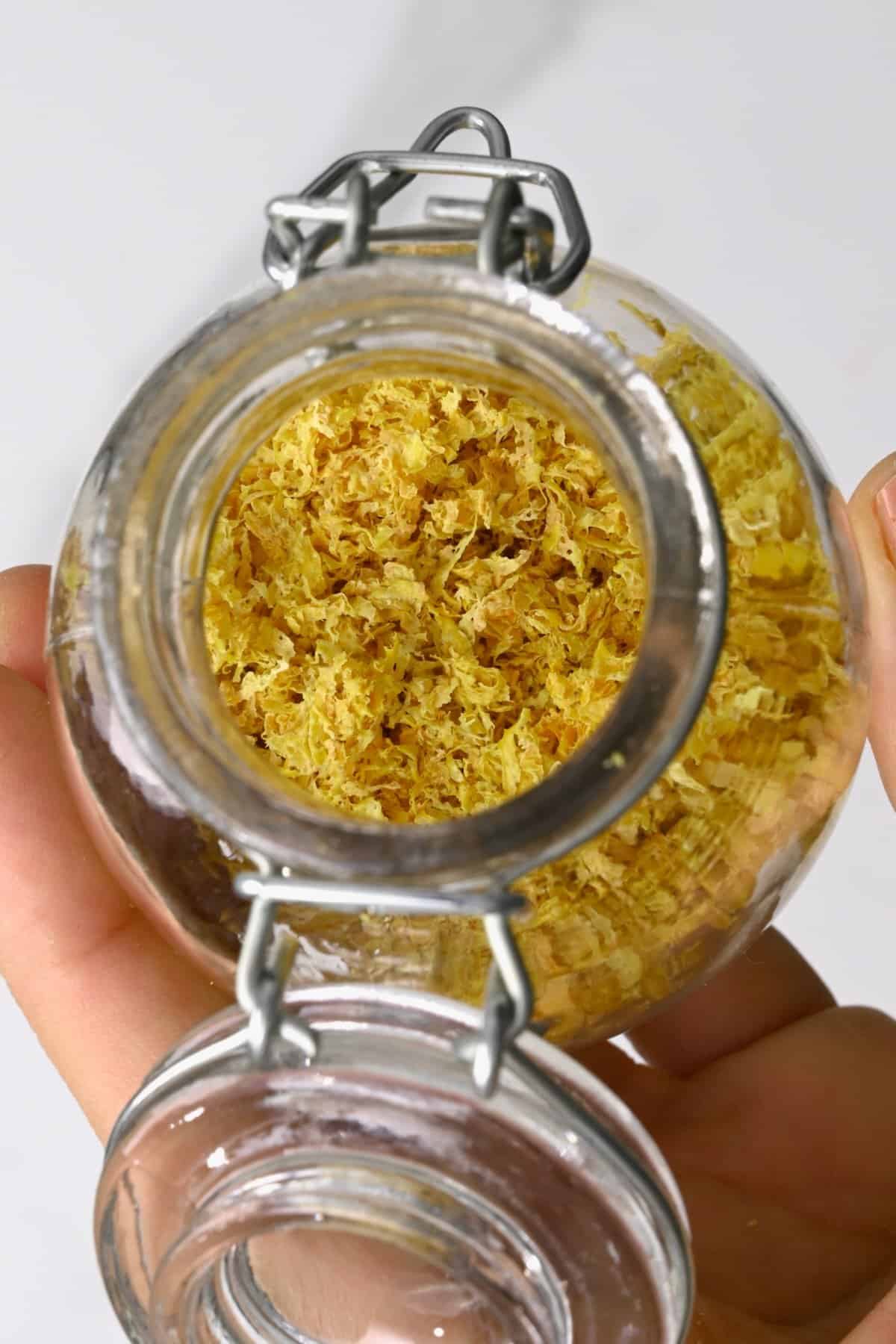
I have shared my top 6 methods for juicing a lemon and having already prepared preserved lemons (also great if you’re a lemonade lover), I made sure to peel or zest all the remaining citrus. Not only does this help to reduce food waste, but there are so many ways to use this ingredient.
While the most common methods are arguably how to make lemon zest with a microplane or citrus zester, below are three additional methods. That way, you can pick a tool based on the results you want and what you have in your kitchen. These include how to zest a lemon with a cheese grater, knife, and vegetable peeler! As a bonus, all of these methods double up as ways to zest limes, oranges, and other citrus fruit, too!
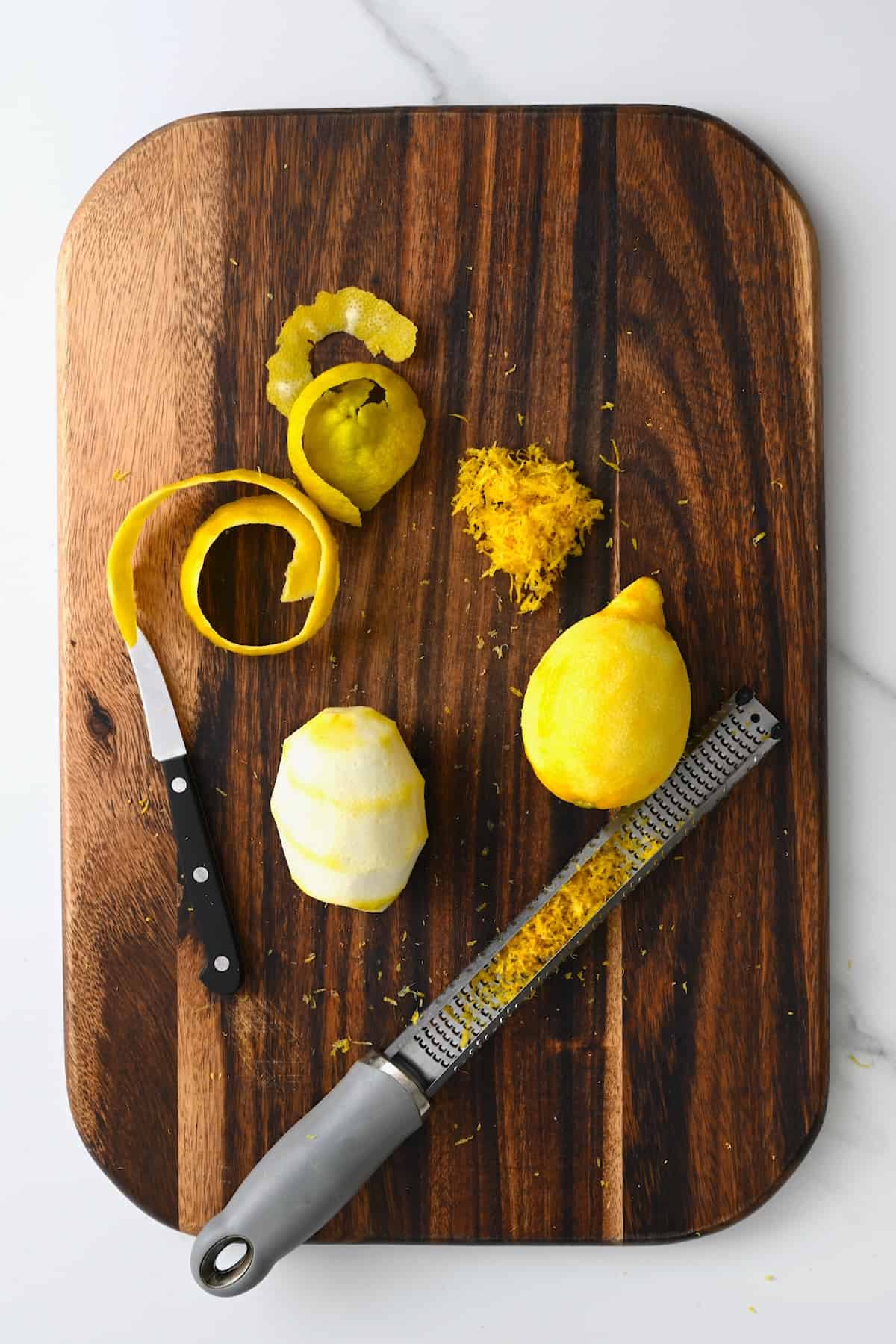
Once zested, this zingy ingredient is perfect for boosting all sorts of recipes/meals, including dressings, salads, pasta dishes, and more. Plus, the methods below help you prepare zest, strands, and strips of the peel.
Want to save this recipe?
What is lemon zest
Lemon zest refers is the fragrant outermost layer of the lemon’s peel. By using one of the methods below, you can obtain lemon zest by removing the yellow portion of the peel (which contains the flavorful oils) while avoiding the bitter white pith. When incorporated into different dishes, desserts, and beverages, lemon zest adds an intense fresh citrus aroma and tangy taste.
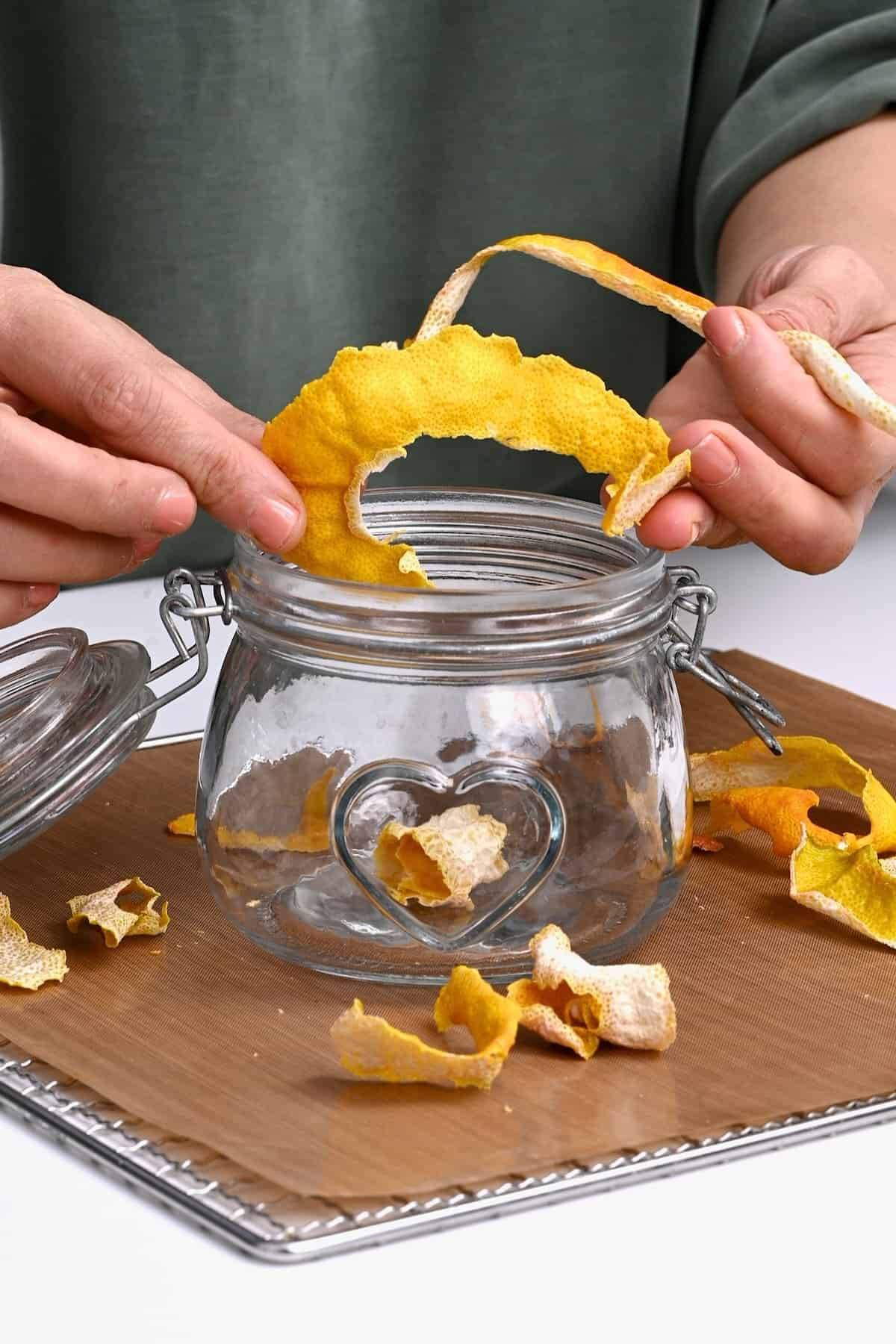
What’s needed
- Lemons: when you plan to consume the zest, it’s best to use organic, unwaxed fresh lemon (to avoid pesticides and other nasties). If they’re waxed, you’ll need to first remove that layer.
- The tools (choose one):
- Microplane,
- Lemon zester,
- Cheese grater (box grater),
- Vegetable peeler (potato peeler),
- A sharp paring knife.
Depending on which tool you use, you end up with different results.
I.e., a microplane and box grater yield a finely grated zest. Meanwhile, a citrus zester will create long strands/curls. Lastly, a peeler or knife will create long strips/pieces of the peel that can be twisted or chopped down.
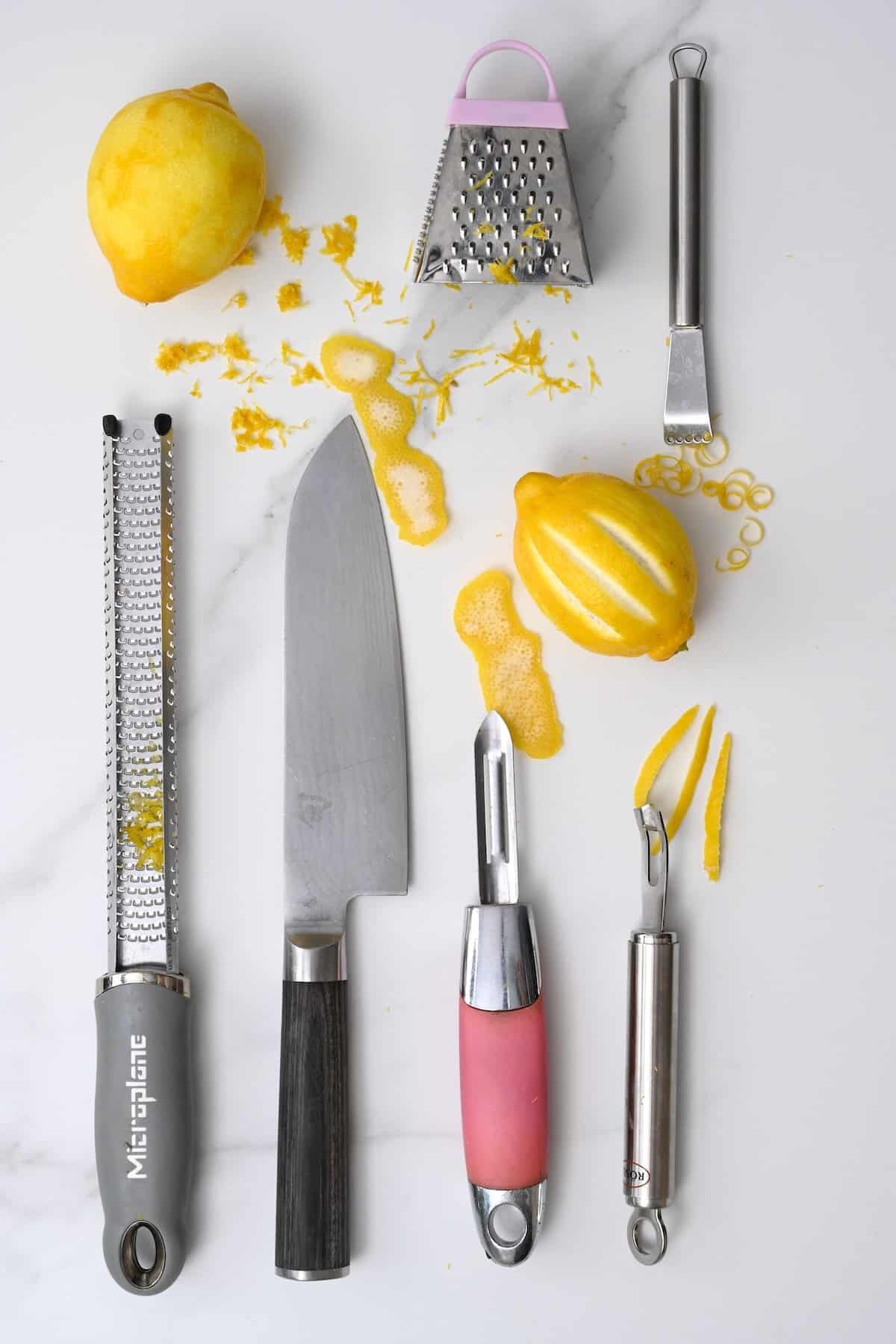
How to remove wax from lemons
It’s best to first remove the wax layer surrounding the lemons (which is used as a preservative). While, technically, it’s safe to eat, it can cause some mild digestive discomfort.
- Place the lemon/s in a colander in your kitchen sink.
- Boil water and then pour it over the lemons, immediately after using a vegetable brush to remove the wax layer.
- Give a final rinse with warm water and then dry the lemons thoroughly.
Alternatively, you could dip the lemons into a large bowl of very hot water for a few seconds OR even use some vinegar or lemon juice to wipe them, then rinse them.
How to zest lemons with and without a zester
Even if the citrus is unwaxed, it’s still a good idea to start all of the methods below by rinsing the fruits well, removing any stickers, and patting them dry.
Chef’s Tips: the biggest tip of all for how to make lemon zest the best way possible is to remove the yellow part of the peel ONLY and not the spongy, bitter white part, aka the pith!
Using a Microplane
This is one of my favorite methods for cleanly zesting the peel away from the pith. Plus, it’s super simple to do, too (and as a bonus, it works well for ginger, garlic, cheese, and chocolate, too). This method will also work with a hand-held grater, though not quite as “cleanly.”
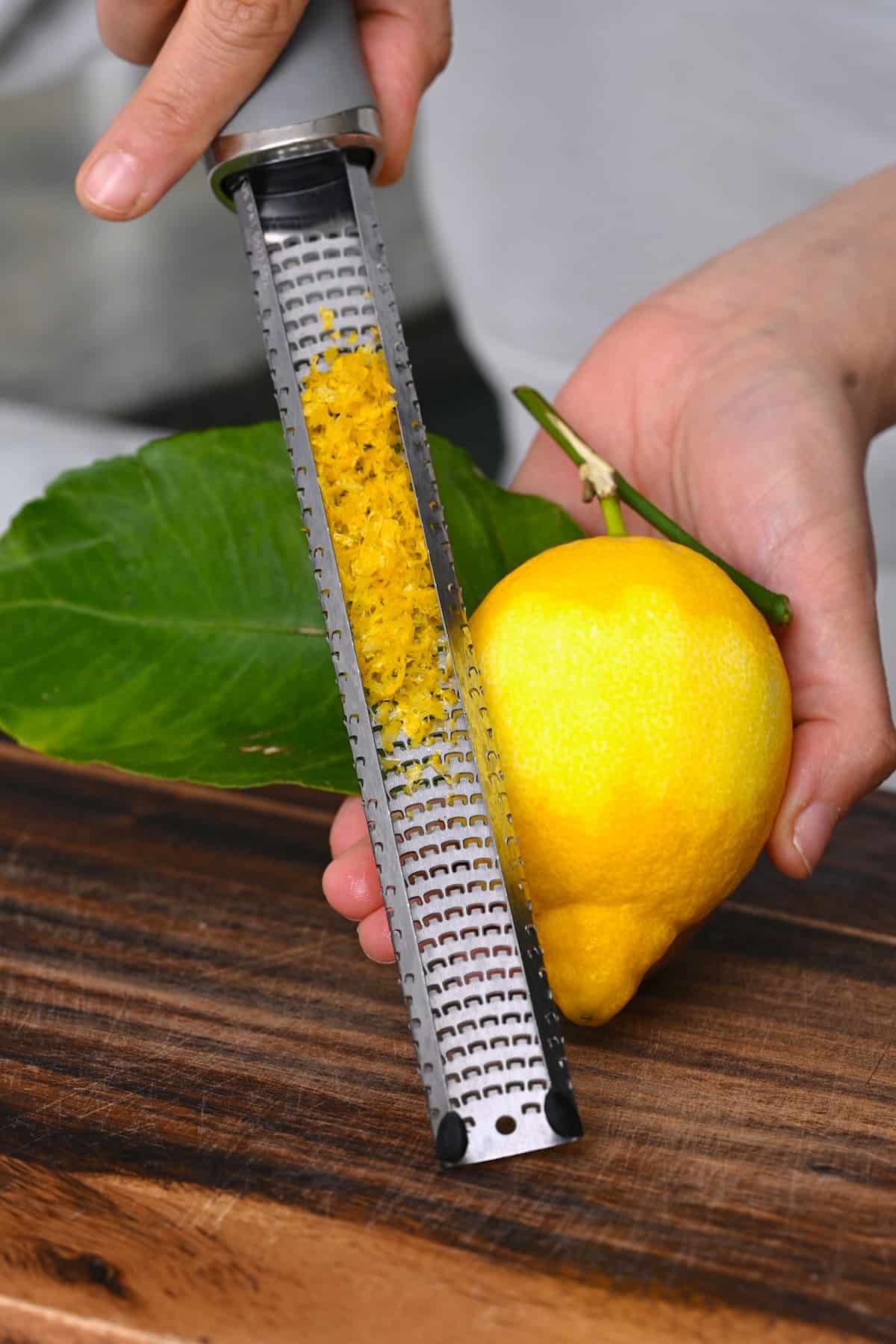
- Hold the microplane grater in your non-dominant hand facing upwards and the fruit in your dominant hand.
- Then, firmly rub the lemon up and down the zester (or hand-held grater), slowly revolving the fruit as you go until all the zest is removed (leaving the white pith behind).
Be careful while doing so to avoid accidentally zesting your finger skin! If you then want to remove the pit before using the lemon, use a sharp paring knife.
With a Citrus Zester
While this method is equally as simple as the above, the results differ – which is why you may decide this is/isn’t the one for you. A citrus zester has several small holes and will yield long strands of peel rather than the very finely grated results, perfect for decorating/garnish and in cocktails. Here’s how:
- Hold the fruit in your non-dominant hand and press the holes against one end of the lemon, firmly holding around the citrus zester.
- Push down into the skin and then pull the zester down the entire length of the lemon to remove strands of the peel.
- Repeat all the way around the lemon, making sure to only get the peel and not the pith.
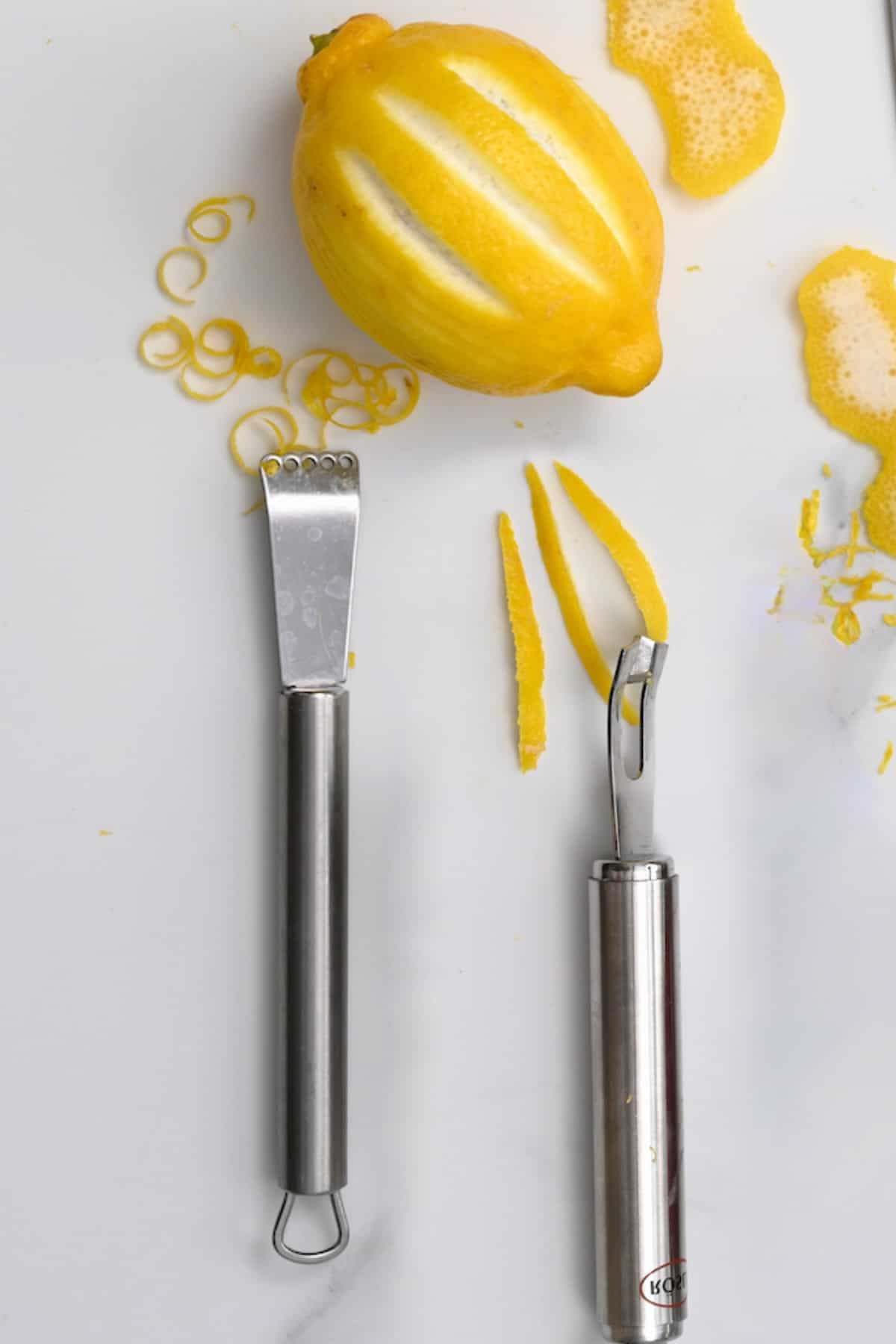
With a Box Grater (Cheese Grater)
Zesting a lemon with a cheese grater is incredibly simple. Plus, many of us already have this tool in our kitchens, making it an excellent option for finely grated results.
- Hold the grater in your non-dominant hand at a 45-degree angle (I find this easier to control than having it flat against your cutting board).
- Then, using the other hand, press the lemon against the side with the smallest holes and rub it up and down, rotating it as you go until you grate the outer layer of the peel (leaving the pith behind).
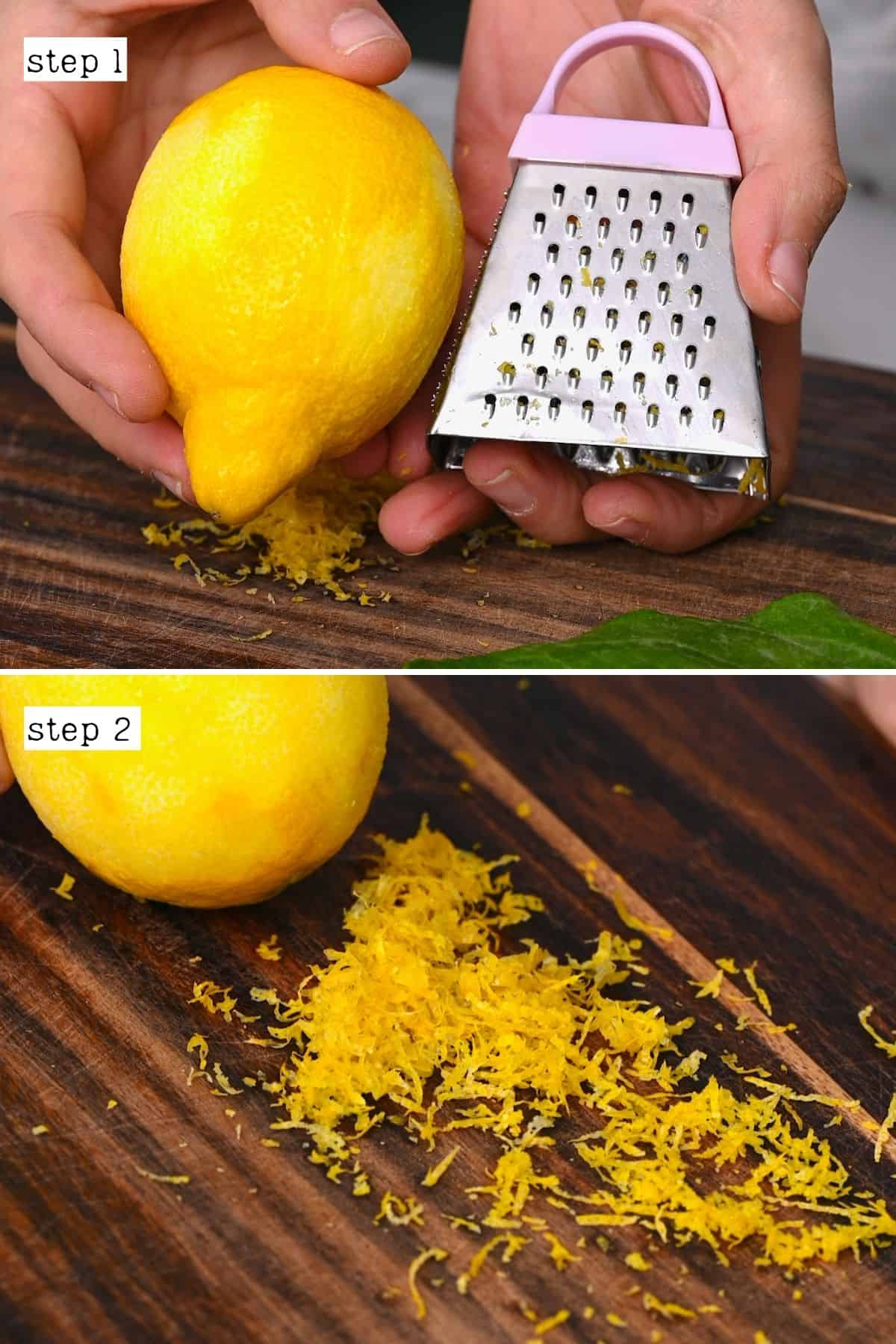
To help release the citrus zest that gets stuck in the grater, just tap it against the countertop to loosen it.
With a Vegetable Peeler (Potato Peeler)
This method is simple but will create strips of peel (perfect for lemon twists) rather than traditional zest, and you don’t have as much control over how deep into the fruit you peel (so may end up with pith, too).
- First, slice the very top and bottom of the lemon off.
- Then, using the vegetable peeler, start from where you’ve sliced and carefully drag it through to the other end of the lemon to remove a full strip. Try not to press it too deeply, so you only remove the lemon part without the pith.
- Repeat all the way around the fruit until all the peel is removed.
- If any pith is attached to the slices, use a small paring knife to carefully trim this away. You can then finely chop the citrus zest strips to your size of choice.
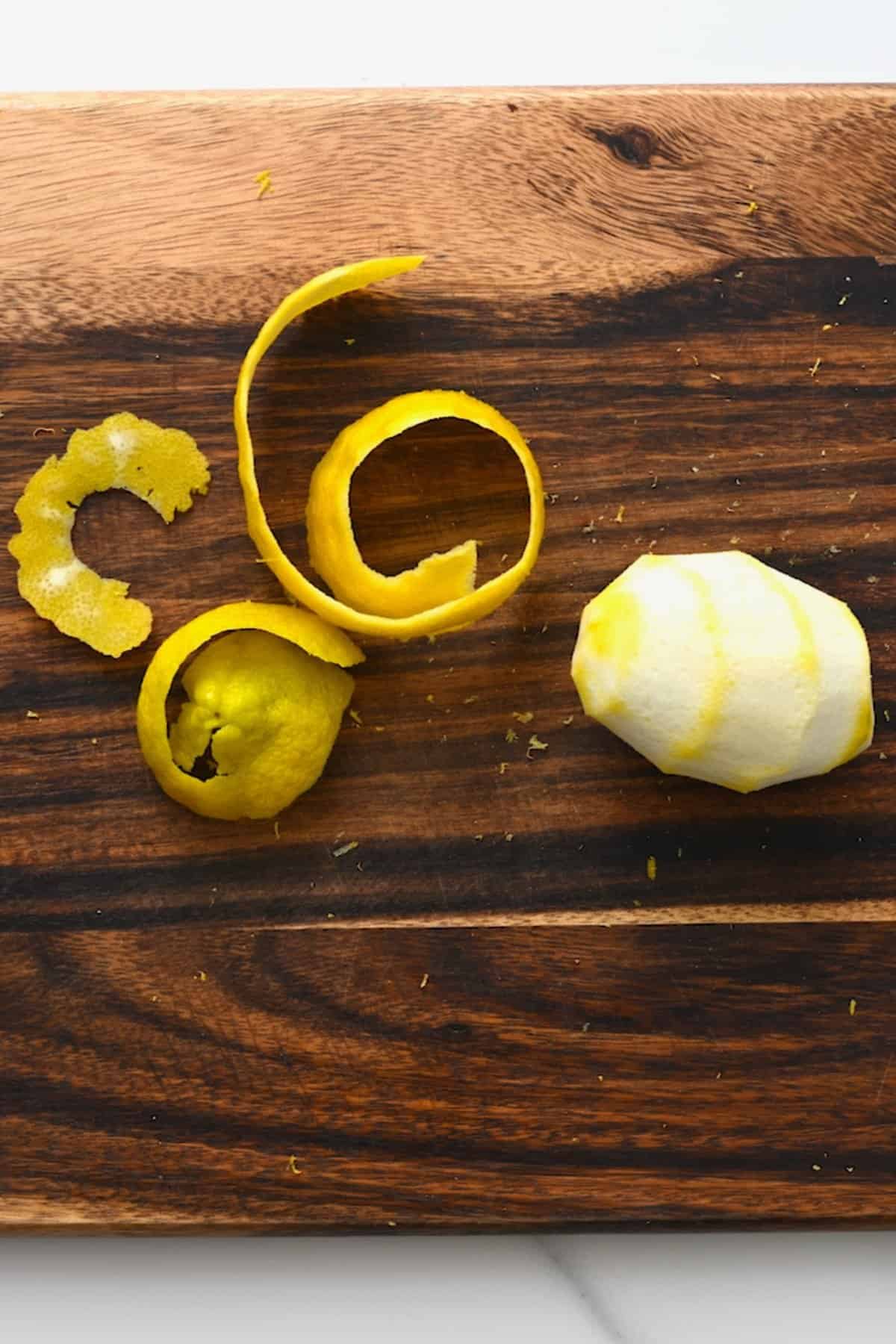
In terms of safety, it’s best to hold the sides of the fruit and peel it away from you to avoid accidentally peeling any skin (which is double ouch when dealing with acidic ingredients!). If the peeler gets stuck at all, you can shimmy it side to side to help it cut through the peel.
With a Knife
This version is usually my last option as it creates strips of lemon peel rather than just the zest and takes longer to remove only the yellow part rather than the entire rind.
- First, slice a small amount from the bottom and top of the lemon.
- Then, place it upright on a chopping board and hold the lemon in place in your non-dominant hand. Using a small sharp paring knife with the other, slice downwards and remove strips of lemon peel, being careful to leave behind as much of the pith as possible.
- Then, if there is some pith attached to any of the peel pieces, press them gently against your cutting board and use a small paring knife to slice away the pith carefully. You can then use the same knife to chop it into smaller pieces/strands to create the lemon zest.
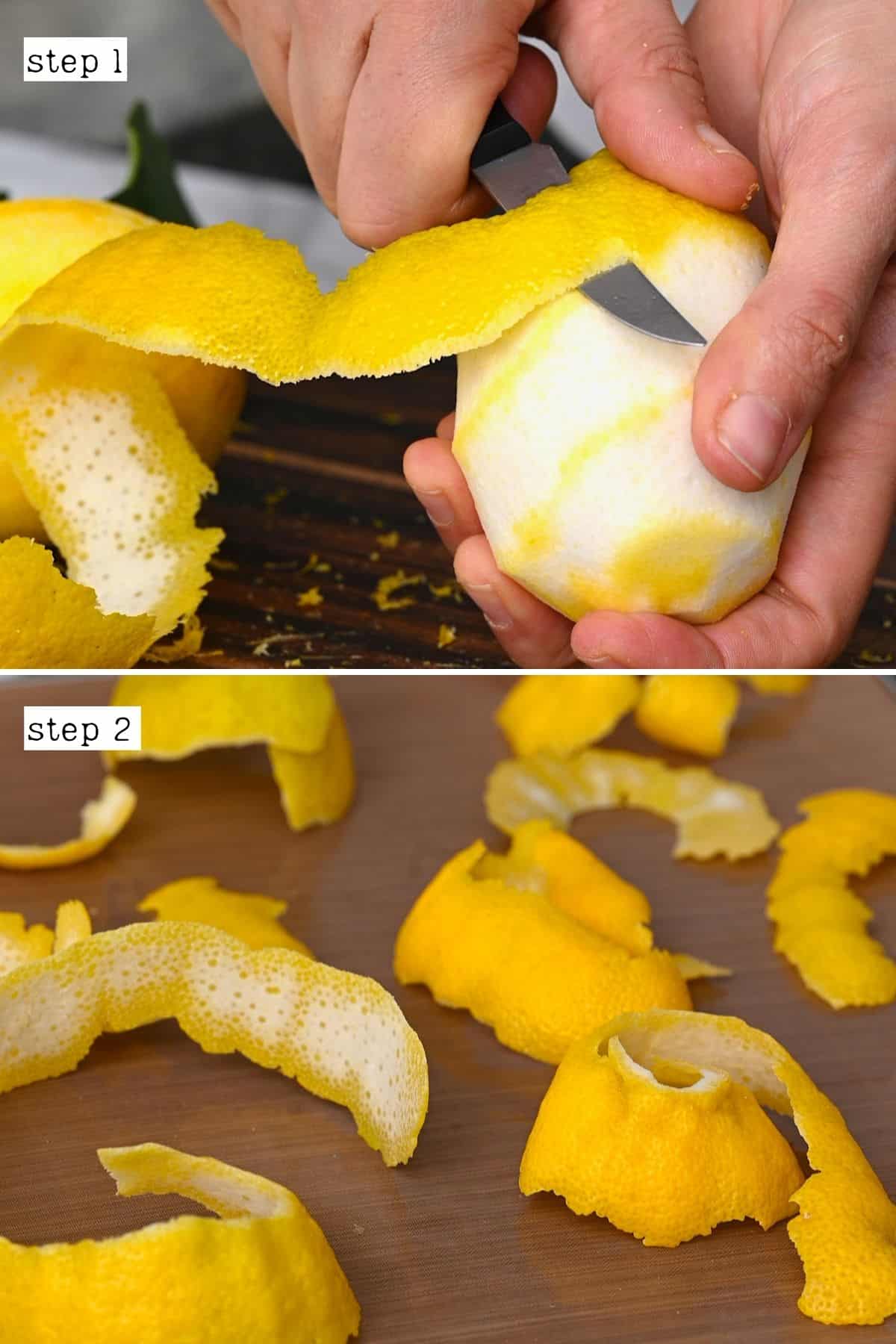
How to Use Lemon Zest?
Here are some of my favorite recipes and ways to use lemon zest:
- Mix into lemon bakes like cakes, Swiss rolls, quickbreads like this blueberry lemon loaf, cookies, lemon cupcakes, etc.
- Use in the crust of tarts/pies.
- OR use it as decoration for the baked goods.
- Add to lemon frosting or glaze.
- Use to make lemon butter (and add to other compound butter).
- Stir into vinaigrettes/dressings and marinades.
- Add to easy lemon pasta.
- Sprinkle over roasted greens like green beans, sprouts, or broccoli.
- Mix it into salt or sugar.
- Sprinkle into salads.
- Mix into fresh basil pesto.
- Stir into soups.
- Add to crumbles and crisps.
- Use in jam and marmalades.
- Add to tea and other soothing drinks.
- Candy the lemon strands/peel.
You could also dehydrate the peel/zest. Then add it to tea, lemon pepper seasoning, crush into a powder, and more!
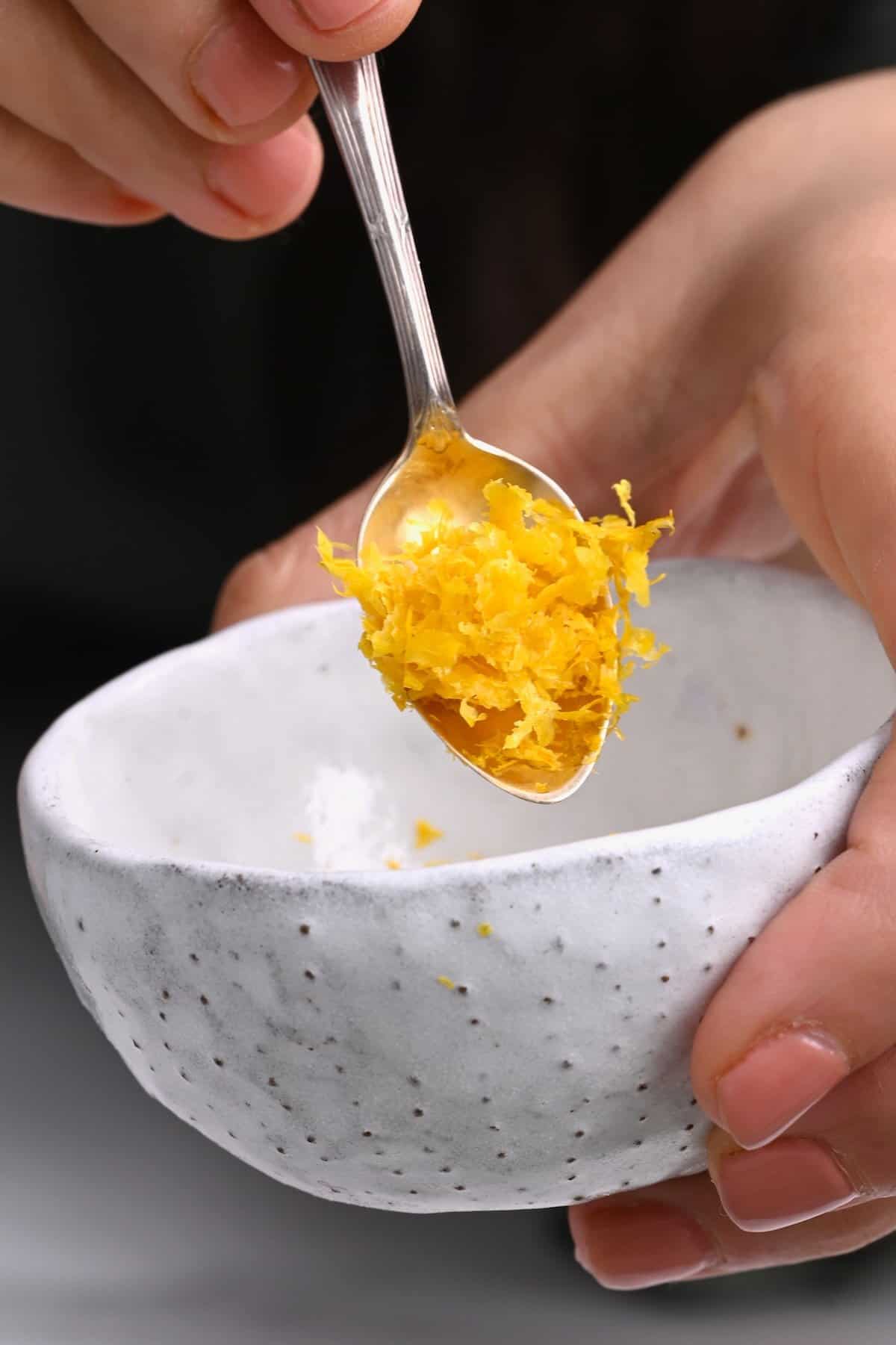
How to store lemon zest
- Freshly grated lemon zest is best. Avoid refrigerating it, as it dries out and loses its natural oils, affecting its quality (though it could last 1-2 weeks in the fridge).
- Freeze the zest by putting it in an airtight container. Or first place in an ice-cube tray and then transfer it to a container once frozen. Label and freeze for up to 6 months. Thaw for a few minutes at room temperature before use.
For longer storage:
- Dry the zest on a lined sheet or in a dehydrator/oven at 100ºF/38ºC until brittle.
- Store the dried zest in an airtight container or spice jar for up to a year.
- Use 1 tsp dried zest for every 1 Tbsp fresh zest in recipes.
More lemon DIYs
- How to Juice a Lemon (6 Ways)
- Easy lemon butter (+ flavor variations)
- The BEST homemade lemonade
- Honey-fermented ginger and lemon
- Lemon Simple Syrup
You might also be interested in How to Juice a Lime (6 Methods)!
If you try one of these methods for making lemon zest, let me know how it goes in the comments below. I’d appreciate a recipe card rating and would love to see your recipe recreations – tag me on Instagram @Alphafoodie!
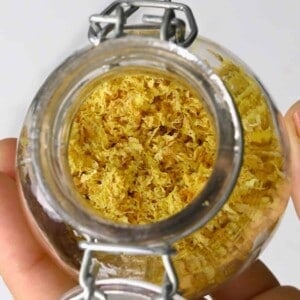
How to Zest Lemon (5 Methods)
Equipment
- Microplane grater – OR –
- Lemon zester – OR –
- Cheese grater/Box grater – OR –
- Vegetable peeler (potato peeler) – OR –
- small sharp paring knife
Ingredients
- 1 lemon
This will yield about 1 Tbsp (3 tsp) of lemon zest.
Instructions
- Rinse the fruits well, remove any stickers, and pat them dry. Then choose your zesting method.See the Notes below for how to remove wax.
With a Microplane (Finely Grated Zest)
- Hold the micropane grater in your non-dominant hand facing upwards and the fruit in your dominant hand.
- Firmly rub the lemon up and down the zester (or hand-held grater), slowly revolving the fruit as you go until all the zest is removed (leaving the white pith behind).Be careful while doing so to avoid accidentally zesting your finger skin! If you then want to remove the pit before using the lemon, use a sharp paring knife.
With a Citrus Zester (Lemon Strands)
- Hold the fruit in your non-dominant hand and press the holes against one end of the lemon, firmly holding around the citrus zester.
- Push down into the skin and then pull the zester down the entire length of the lemon to remove strands of the peel.
- Repeat all the way around the lemon, making sure to only get the peel and not the pith.
With a Box Grater/Cheese Grater (Finely Grated Zest)
- Hold the grater in your non-dominant hand at a 45-degree angle (I find this easier to control than having it flat against your cutting board).
- Then, using the other hand, press the lemon against the side with the smallest holes and rub it up and down, rotating it as you go until all the peel is removed (leaving the pith behind).To help release the zest that gets stuck in the grater, just tap it against the countertop to loosen it.
With a Vegetable Peeler/Potato Peeler (Long Peel Strips)
- Slice the very top and bottom of the lemon off.
- Using the vegetable peeler, start from where you've sliced and carefully drag it through to the other end of the lemon to remove a full strip. Try not to press it too deeply, so you only remove the lemon part without the pith.
- Repeat all the way around the fruit until all the peel is removed.
- If any pith is attached to the slices, use a small paring knife to carefully trim this away. You can then finely chop the strips to your size of choice.In terms of safety, it's best to hold the sides of the fruit and peel it away from you to avoid accidentally peeling any skin (which is double ouch when dealing with acidic ingredients!). If the peeler gets stuck at all, you can shimmy it side to side to help it cut through the peel.
With a Knife (Long Strips)
- Slice a small amount of the top and bottom from the lemon.
- Place it upright on a chopping board and hold it in place in your non-dominant hand, using a small sharp paring knife with the other to slice downwards and remove strips of lemon peel, being careful to leave behind as much of the pith as possible.
- If there is some pith attached to any of the peel pieces, press them gently against your cutting board and use a small paring knife to slice away the pith carefully. You can then use the same knife to chop it into smaller pieces/strands to create the lemon zest.
Storage Instructions
- The best results will always come from freshly grated lemon zest. Fridge: It will last between 1-2 weeks but I don't recommend refrigerating it as it starts to dry out and lose those natural oils. It's better to freeze or dehydrate it.Freeze: You can do so in a small airtight container/jar/Ziplock bag, OR my preferred method is to portion it first. Place portions (tsp or Tbsp) of zest into an ice cube tray and press down to pack tightly. Then freeze until solid. Once solid, transfer to one of the above and freeze for up to 6 months. I recommend labeling the container, too. When you want to use it, simply allow it to thaw at room temperature (for just a few minutes) and enjoy!Dehydrating: Do so either spread out across a lined baking sheet at room temperature (best in dry climates, may take several days, toss once a day) or in a dehydrator/oven at a low temperature around 100ºF/38ºC (use the oven at its lowest temperature and slightly crack the door if necessary). It's ready when the pieces are brittle and snap. Transfer to an airtight container and store for up to a year. Use a teaspoon of dried zest per every tablespoon of fresh zest called for in a recipe.
Notes
2. Boil water and then pour it over the lemons, immediately after using a vegetable brush to remove the wax layer.
3. Give a final rinse with warm water and then dry the lemons thoroughly. Check the blog post suggestions on how to use the zest!
Nutrition
Nutrition information is automatically calculated, so should only be used as an approximation.


















Hi I love all the ideas but my lemons are green and they are not limes and have a very strong zest so I have to be very careful not to use too much or it spoils the lemon curd and has a bitterness to it. How do I figure out how much to use so not to spoil my dishes a pie, a salad. A lemon curd even lemon juice can get spoiled by the tangy zest. They are not yellow lemons or limes they are big green lemons.
Hi Margaret,
I would taste test – first add a little bit to your recipe and taste. Maybe add half or even 1/4 of what a recipe calls for as you can always add a bit more to taste. I’m sorry I can’t provide you with more details.